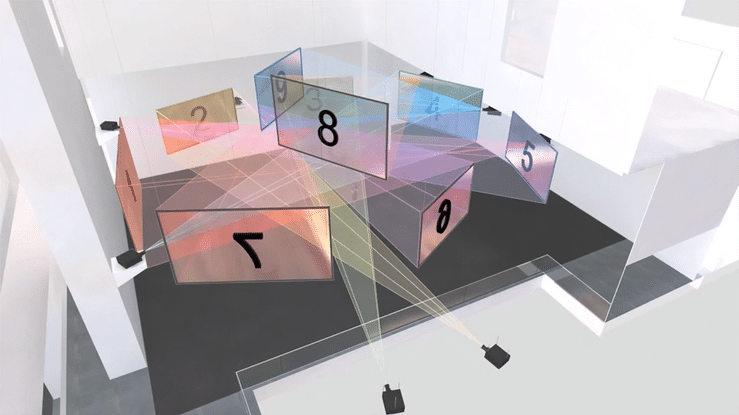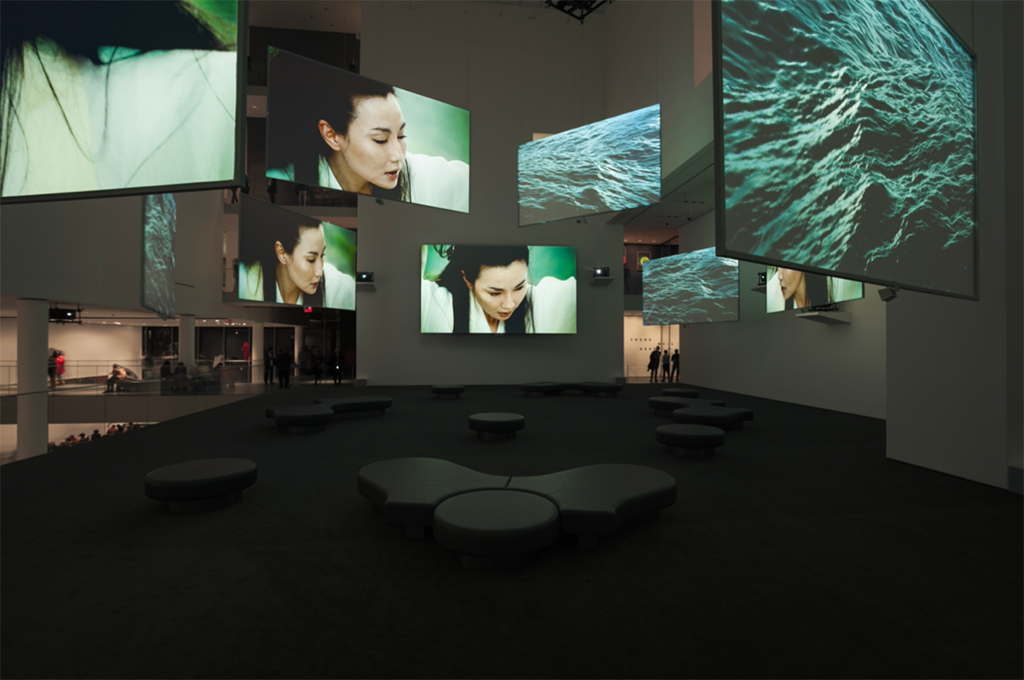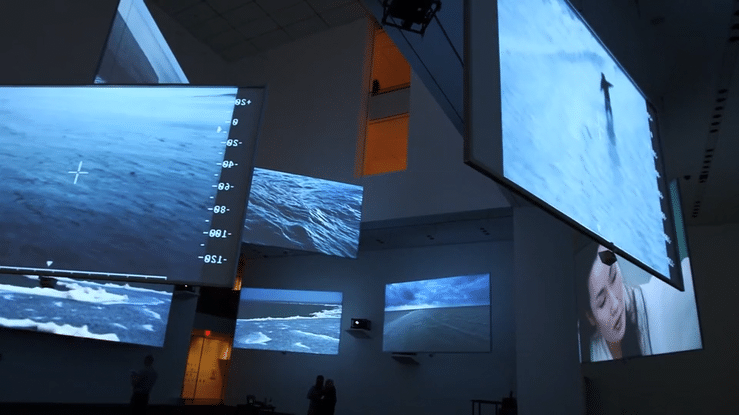Beyond the Expedient: An Interview with Isaac Julien
Ernest Larsen & Sherry Millner
From the very beginning of his career as a filmmaker, even before the seminal Looking for Langston (1989), in the films he made with the Sankofa Film Collective, Isaac Julien directly problematized what he regarded as the compromised innocence of the gaze of the documentary camera, while proposing a new political aesthetics of the cinema. In his many films and installations since the early 1980s, Julien’s camera seldom, if ever, merely looks at or records the flow of situations and actions. It might be said à la Langston to look for its subject, precisely to look for what in his view remained hidden from the conventional documentary camera. These projects— often involving journeys to sites far-flung from his home in London, from Lampedusa to Shanghai—take off from a hard kernel of the real/the factual (an historical figure, a disaster, a social crisis) and then through a palimpsest of research, questioning, and stylization take on the expansive faceted character of a symphonic reworking of its original inspiration. This interview conducted via Skype in July 2017 attempts to reckon with a few of the risks and rewards of Julien’s undertaking.
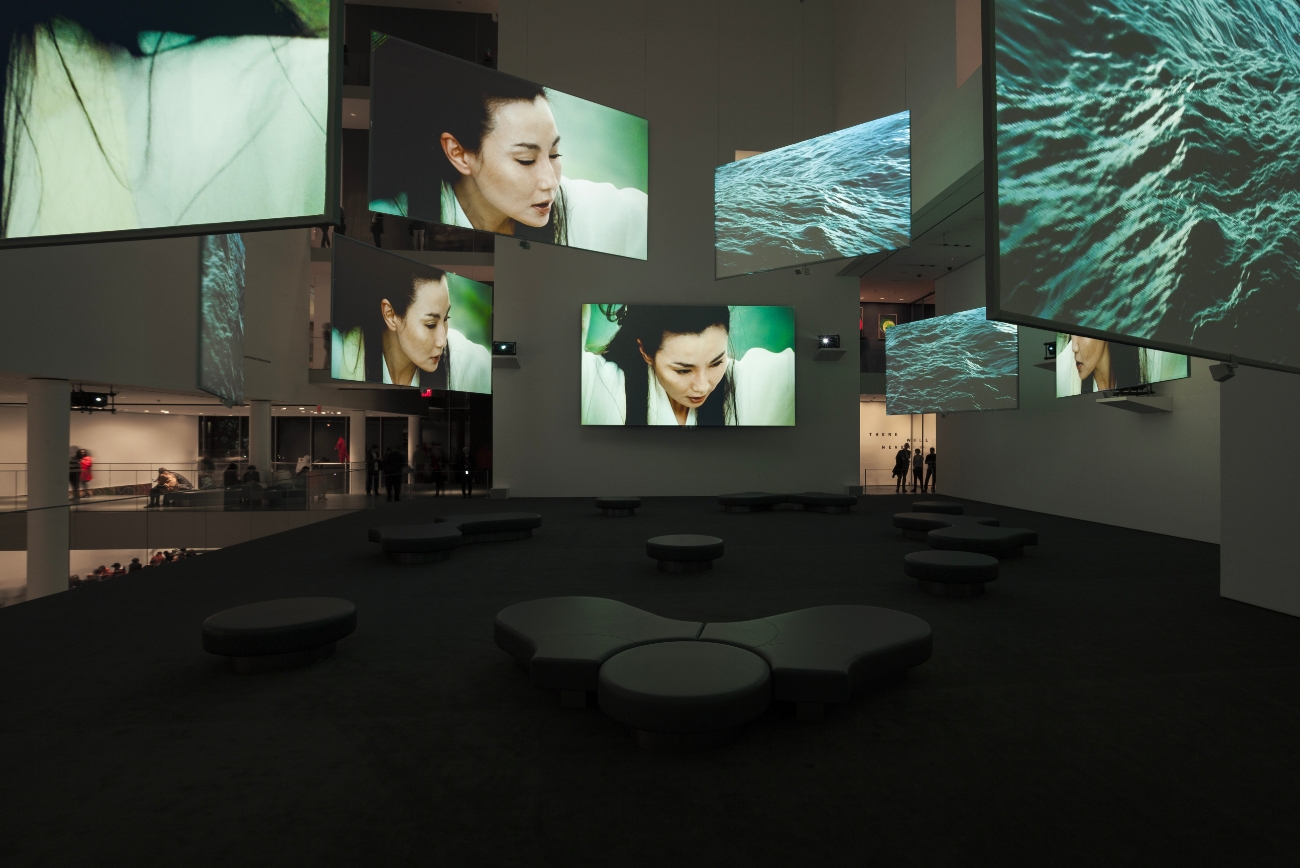 Installation view of TEN THOUSAND WAVES (2010) at The Museum of Modern Art (MoMA), New York, 2013-14. Nine-screen installation, 35mm film transferred to High Definition, 9.2 surround sound, 49’41 Photo: Jonathan Muzikar.
Installation view of TEN THOUSAND WAVES (2010) at The Museum of Modern Art (MoMA), New York, 2013-14. Nine-screen installation, 35mm film transferred to High Definition, 9.2 surround sound, 49’41 Photo: Jonathan Muzikar.
The two of us (SM & EL) have, to make the record clear, a long and valued friendship with Isaac and his partner Mark Nash and I (EL) have written about some of his films. As filmmakers of a more anarchic persuasion, we have also built a dialogic relationship with Isaac–at times genially disagreeing about our mostly shared perspectives. The laughter we shared while conducting this interview has been left on the cutting-room floor, as it were (one of Isaac’s characteristic phrases). But I can still hear it.
Interview
Ernest Larsen
First, we want to ask a few questions about the particular route you travel from the initial conception of an installation project to its realization– and even to its reception. Distinctively your installations often exploit various configurations of multiple screens. Such configurations can be seen not as immersive necessarily but as fracturing–or perhaps both at once. As a result, the willing viewer must reckon with choice, with displacement and replacement. How do these notions of the positioning of the participating viewer play into your structuring of the multiple scenic or tableau effects?
Isaac Julien
I think the first thing to say is that because of the ways that digital technology developed from, say, the mid-1990’s into the millennium, some of my developing ideas about montage and installation became inextricable parts of the process of building my more recent multiple screen works. For instance, I initially made three-screen works, but then when I began to experiment with the idea of making more than a three-screen work, that meant moving away from what I was calling the ontological gaze to something more immersive.
For example, my 2005 solo show ‘Fantôme Créole’ at the Pompidou, curated by Christine Van Assche, in which I was very involved, was a very interesting experiment around my four-screen work called “Fantôme Créole.” We put all of the seats into the center of the gallery space—the spectator was surrounded by all images on all four sides. The idea was that, in a sense, the spectators would become their own editors since they would not be able to see all the screens at once. What actually happened is that the spectators came in and, since the seats were moveable, they moved them to the furthest distance where they could have the experience of being able to see all screens at once – all four screens at once.
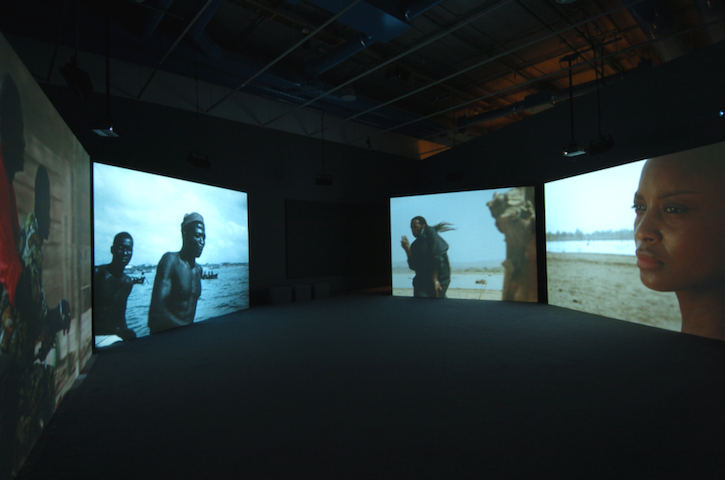 Installation view of FANTÔME CRÉOLE (2005) at Centre Pompidou, Paris, 2005. Four-screen installation, 16mm film
transferred to digital, color, 5.1 sound.
Installation view of FANTÔME CRÉOLE (2005) at Centre Pompidou, Paris, 2005. Four-screen installation, 16mm film
transferred to digital, color, 5.1 sound.
So what we decided to do then—this was back in 2005—was that it would be great to be able to make a work where the spectator didn’t necessarily have that choice. In making a nine-screen work like Ten Thousand Waves (2006-2010) for example, the idea is that there are many points of views because the screens are double faced. In a way viewing becomes a space where the spectator can never gaze between screens, looking at the back of the screen or the front of the screen. At the same time the work had to be precisely conceived in terms of how it was going to be shot and edited. All of these considerations had to be specifically correlated, in aspects of shooting and planning the design of the installation.
IJ (continued)
So these aspects of the creation of the work came first and formed the model for how we would shoot the work (given the complex technical requirements of making creative use of the nine screens) and then how we would be able to conceptualize the sound design. The sound would have a sonic ambulatory aspect to it, where the spectator would be encouraged to move from one screen to the other because of how the sound was arranged and dubbed, or calibrated, across a 9.2 surround system in relationship to the mid-point to surround tracks for the work. And so all of these things develop as we are making the work. But at the same time I think it was ultimately based on the idea of the mobile spectator, putting that back into practice. Now whether that works or not is another question, audiences still like sitting down to view works…
(Laughter)
Because of course you can make a work and people can view it and react to it how they want to and, in a way, I’d say, old habits die hard. People sometimes remain stationary. But there’s a way in which there’s encouragement for the spectator to be able to enjoy having multiple perspectives to view the work–encouragement to be able to engage with the work in this immersive manner. And so this became a kind of raison d’etre to the work and part of that also connects to how you shoot the work because you also have to develop the technique for shooting these different perspectives. I shoot with several cameras at once in a scene. And then being able to montage the work, which is a considerable but exciting challenge for the editor, Adam Finch.
So I must plan the whole development in both the sonic and the choreographic aspect and their mutual relations. It’s an experiment that you are able to undertake in a museum/gallery context as opposed to the classical cinema context. This is something that has been a very unique experience for one to explore — and yet has also become part of the lingua franca of contemporary moving-image work. There have been a few video artists that have also looked at my work and they’ve attempted to also make this a part of their sort of language. I recognize that this way of working has gained a certain currency. But at the same time, I think that that’s just one way of working out the permutations of multiple screen installation work when you’re interested in choreography. This works best when the relationship to sound creates the ambulatory possibility for the spectator’s experience, and identification, rather than producing normative classical film approach.
EL
That ambulatory aspect suggests that the viewer is choreographing the situation himself/herself to some degree. Would you say in a way that notion enhances the “freedom” of the viewer to make their own decisions? Is that a calculation?
IJ
Well, I think all of these things are suggested when you edit the work, but in practice how a spectator reacts to the work is really very unique. I could say I encourage a more reflexive relationship to how I might want the spectator to participate in viewing the work. Think, for example, of one of Bill Viola’s early quite famous works, Five Angels for the Millennium (2001). It was a bit more didactic. Basically, the spectator had to wait for an irregularly scheduled event where a fully-dressed male character, or ‘angel’, would descend or ascend through water et cetera, and I think that was something that was event-driven, but thrilling when it was made.
EL
Let’s take that point. Here’s Bill Viola, who’s doing a lot of his work at least at that period on impulses that we might call mythical, spiritual, or even archetypical to some degree, whereas a lot of your installation work has an originary documentary impulse. So how does the structured configuration of screens complicate or inflect where you start out, what the original documentary impulse is, the information on which to base the real, whatever that may be from project to project? Do you have a sense of how these original impulses developed or transformed based on your knowledge of how you want to structure an installation?
IJ
Well, I think there was a factor that was necessary to, as you say, the documentary impulse or the archival impulse, in the early works in 89′ or the mid-80s, such as Looking for Langston (1989) or Territories (1983). My work, however eclectic, is working with this documentary impulse to undo what constructs these ethnographic codings around the documentary and the realist impulses around documentary form. We want to undo that because we don’t like how the black subject is being framed in these various modes ethnographically. We want to undo it or deconstruct it some way.
So I think through that relationship to the political, and try to make works that somehow respond to events in the world or respond to events that affect one in a more intimate sense. When I think about questions, for example, of migration, these are sort of questions which we’ve been thinking about for a long time. Take a work like Western Union: small boats (2007), which was made more or less ten years ago now. It was shown at the Royal Academy as a five-screen work. It has a very mixed economy: film projections, flat screens, and light boxes, so actually it’s a six-screen work, but as a hybrid. I think on the whole it’s a way of trying to take this question of migration, which I was interested in and which was spurred on by a visit to Italy with my mother. I was also in conversation with critics like Iain Chambers and Lidia Curti who teaches in Naples and looking at the changing population as I came to Italy. Now, of course, that situation has taken on international media attention but when I initially made the work, it wasn’t noticed by anyone on such scale.
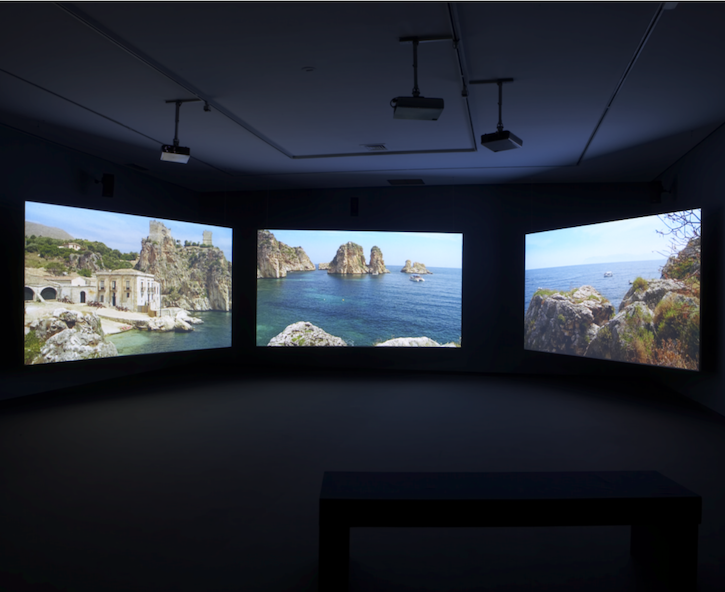 Installation of WESTERN UNION: SMALL BOATS (2007) at Galería Helga de Alvear, Madrid, 2008. Three-screen film installation, 16mm film transferred to digital, colour. 5.1 sound, 18’22” Photo: Joaquin Cortes
Installation of WESTERN UNION: SMALL BOATS (2007) at Galería Helga de Alvear, Madrid, 2008. Three-screen film installation, 16mm film transferred to digital, colour. 5.1 sound, 18’22” Photo: Joaquin Cortes
IJ (continued)
So, I think there’s a way in which the documentary impulse comes from wanting to document things but at the same time to not document things in the way the dominant media documents such events. Then there is the question of reconstruction: all of these themes come into play; usually through fictional elements. All of this questioning of how the form of what a documentary imparts is something which also connects to the way in which it becomes fragmented. For me, there has to be an alibi, a deeper motivation, as to why I make works in the museum or gallery context as opposed to a more documentary or televisual context and that’s where the question of multiple screens and the possibilities for making those came up. I think you’re right that there’s a way in which I still want to engage in the political. But I would say how I engage in that political is often through a different strategy, using documentary questions which are ordinarily dealt with in a more straightforward manner, a realist manner.
The idea is that you make works that hopefully live on beyond the expediency of something which is newsworthy and I think there is an open question as to what is newsworthy. Sometimes when news becomes really very important you need it to signify beyond its sell-by date which is nowadays instantaneous through social media platforms… All of those things come into play. A work like Western Union: Small Birds took 10 years before the work was shown in Britain, before it would receive recognition. It recently won the Charles Wollaston Award at the Royal Academy Summer Exhibition where it was exhibited this summer.
It’s interesting because I’m talking to you from Italy. I’m looking out on the Mediterranean Sea on vacation, but I’m very aware that all of those journeys are still taking place now. They haven’t stopped, only increasing.
EL
No.
IJ
I think it’s very much about how can you make work that transcends its moment and at the same time is embedded in its original strategy that can resonate in some way. I think one of the things about making the multiple screen works in terms of the documentary impulse is the way that you can enliven that impulse by making it become a sonic work which can somehow enable the actual documentation or the way in which you may want to film certain elements. So, there’s an element which could be archival that could be mimicking documentary modes but highlighting the political aspect in them as a way of trying to charge them with memorialization. All of that is created through the use of sound, through the use of montage and using these elements to dramatic effect, to try to create an intervention into how these questions are ordinarily presented.
I think that’s really one of the ways that I’ve been working for quite a long time in relationship to the questions of documentary impulse, and I think that is something obviously that other filmmakers have been involved in as well.
Sherry Millner
Even in your single channel work and your “documentary” work you always question or subvert, again, the realist–the documentary realist–form and take it elsewhere. So maybe you could talk about that–what the camera does, what you do with the camera and with the staging that subverts, or at least questions, again, the conventional documentary impulse.
IJ
I think of films like Fanon: Black Skins White Mask (1996), and earlier works like Territories and Looking for Langston and I think all of those works are about trying to create a different intervention into the film essay and to embolden that image with something which could be fictional, a tableau vivant, that could be imagistic, that could be all or any of these things. Quite often, audiences have felt as if the coding is very marked in relationship to the image, perhaps too coded.
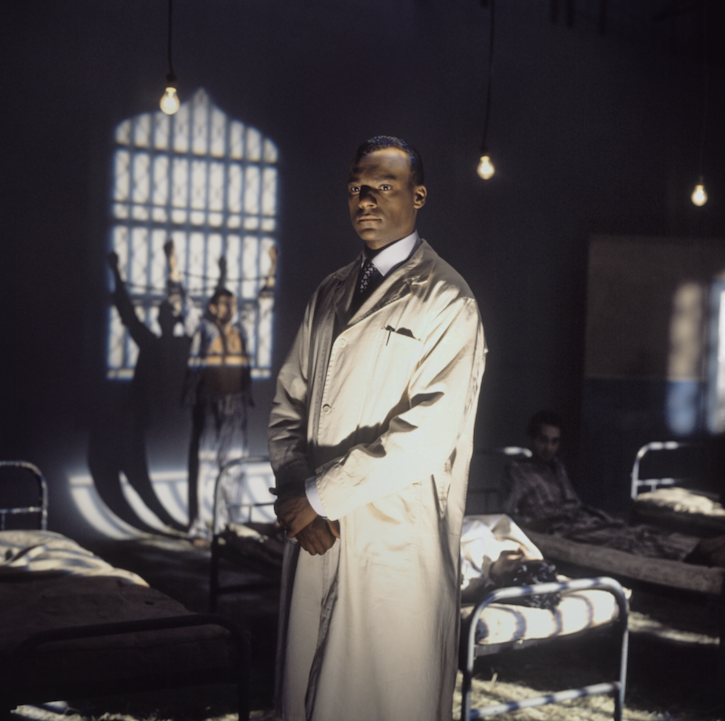 Still from the film FRANTZ FANON: BLACK SKIN, WHITE MASK (1996).
Still from the film FRANTZ FANON: BLACK SKIN, WHITE MASK (1996).
And I think those things are trying to bring all of these different effects to the documentary and to question what that mode of documentary visualization could be in terms of its form and in terms of how you might want to think about presenting questions of this nature. It’s been an interesting journey. I think about my work in relationship to how new technologies impact upon making the work in a particular context and how it resignifies in a gallery or museum context with precisely this level of engagement. I can see that my colleagues have been inspired by this when I think about someone like John Akomfrah. I certainly think that in The Unfinished Conversation (2013) … you know, John Akomfrah was not making three-screen works initially.
(Laughter)
EL
No he wasn’t.
SM
No, that’s really interesting to watch.
IJ
So I think there has been a kind of move. Today I’m someone who really was pioneering that kind of move into the museum and gallery space but also we know that what becomes a way of thinking about making films, that in one context can be seen as fairly avant-garde, can then become very normative, once institutionalized.
I do think there is also a political moment around multiple screen works, with three-screen works in particular becoming a more normative practice. I think that’s happening because there’s been an opening up for these ways of working in the museum context. Institutions take a long time to respond and at the same time I think you know we can say that it’s became a certain lingua franca. Whether one has to move on…
(Laughter)
SM
But also you do move back and forth. You reconfigure and rethink both the audience and the space you’re working in. The kind of material you’re working with, and you do move back and forth among these kinds of different viewing situations in your work.
IJ
I have lots of ideas of what I’d kind of like to do in the future and when I talk to programmers and things like that, they say to me, no, that’s not possible yet, Isaac.
(Laughter)
EL
Oh really?
IJ
But you know there are lots of things I wanted to do on Playtime, for example, which I think in the future I might be able to program into a work but I won’t be able to do it yet.
EL
I want to turn to a long, hopefully not overly complex, question. We watched Fanon for the first time in some years last week.
SM
It struck us how it speaks to this moment.
EL
Yes. In the context of that film’s use of interviews with Fanon’s family members and with theorists like Homi Bhabha and Stuart Hall and Maryse Conde and its stylized reenactments and voice overs and, I have to say, its bravura use of archival footage, including key moments from Battle of Algiers (1967), we noted three shots from J’ai Huit Ans, the 1961 film by Yann Le Masson and Olga Poliakoff. There’s a series that I suppose you would remember, a series of three close-ups of three eight-year-old boys who stare at the camera maybe blankly, maybe defiantly. This is a film that Fanon himself suggested to Renee Vautier, who then suggested it to Le Masson and Poliakoff. The boys whom Fanon in his working role as a psychiatrist treated as a result of the trauma of the colonialist war. These sons of Algerian revolutionaries were filmed in Tunisia in a refugee camp. So to us it was really startling in your re-use of those shots, this decision accords so smoothly with your treatment of an idea as developed in your Fanon of the gaze. There is a certain form of, let’s say, direct address, which your film theorizes in relation to the key text by Fanon in which for the first time he sees himself being seen, called out as black by a French child in the street. So all of this for us comes together and we are wondering if you could talk a bit about how your understanding of documentary form crosses over this idea of seeing yourself being seen, especially in relation to trauma, and then perhaps you could also comment more briefly on this structuring of the gaze, direct address,. It implies direct contact with the viewer, especially in the unavoidable context of desire, or mutual desire, or cross-race desire. That’s a lot but maybe this could suggest some things to you.
FRANTZ FANON: BLACK SKIN, WHITE MASK, 1996
IJ
Well, I think you perfectly described some of the ideas from the Fanon film in your question. One of the things I’ve been involved in recently with Mark Nash has been a project with the British Film Institute and our studio in order to revise Fanon. It will be released as a DVD/Blu-Ray in the fall. Mark has had to go back to the original negative and to a lot of primary sources in the work. We did this because we wanted the work to resignify to a new audience. We think it’s very important that the Fanon film be seen by an audience today.
EL
Yeah, I agree.
SM
That’s great…
IJ
In part, because of this moment of Black Lives Matter and broader questions around violence and around Arab-ness that surround it. These are questions we were looking at when we made the Fanon film. And so I think we were very much interested in Rene Vautier’s film that he initiated in Algiers, in which you have this sequence where the boys return the gaze. I think really a lot of the works in this particular moment, as well as in earlier works have been about the return of the colonial gaze, or the imperial gaze, and the direct look into the camera. But I think at the same time the question of fracturing and of trauma and of the way in which in Fanon’s work he was trying to look at this question of violence and violence which is connected to the gaze to conflict in relationship to decolonization.
These are still ongoing struggles and they’ve come back into the present in a very particular manner. When we were making the work, we were forced to come to terms with what was happening in Algeria. We couldn’t travel there to film because it was too violent at that time. In the sequence at the end of the work you have Fanon’s son discussing the mysterious relationship between the army and crime and people not being quite sure where the violence was coming from.
In terms of the terrorism that was beginning to take hold of the country in that particular moment, it would be this very notion of terrorism in a cathectic sense that would become the lingua franca. It would become the experience in the first world metropolis The United States experienced September 11, but since then it has been much more an imagined psychic reality, as opposed to something that has been practiced in a different way in Europe. I think this question speaks to the unfinished business of the way in which racial and religious regimes haven’t been contested as well as to what constitutes citizenship and how we react to the developments that have taken place.
Think about the relationship between Stuart Hall, when he talked about Fanon and the way in which Fanon was involved in the liberation of Algeria at a point when the country was more secular, but that secularism didn’t necessarily win out. I think we’re still living with the question of that vision of a more secular kind of future. And it just speaks about Fanon not really understanding the relationship between that vision and other religious forces at that time. I think that we’re still there in that moment. In terms of crisis, different regimes want to exploit that to various ends. So I think that it’s very interesting how we think around this question of violence coming back to haunt the metropolis.
And, how can we find the language for thinking about these questions? I believe that we can turn to some of Fanon for thinking about these questions and we notice that the violence of the gaze and how that gets enacted upon in militarization, in war, in police methods, all of these tropes have come back really and have not gone away and have been revisited back onto black bodies in a particular manner which I think is not really the way we envisaged the future.
I think there’s really a lot of work to do in how we’re going to think through and combat these questions. We probably need to look at Fanon again in a slightly different articulation from how we looked at Fanon originally, but nonetheless it has its resonance.
SM
Very much it’s surprising how important that is-
EL
Would you think of going back to the original material? Are you thinking of making a new director’s cut? A more expanded version or a different version, or adding to it?
IJ
The version that most people have in the U.S. is fifty minutes long, without the Maryse Conde and Homi Bhabha interviews. We are also doing some work towards the DVD release, using the archive and other material such as outtakes. We would like to go back to the old interviews and have it in a long form manner, etc. Mark (Nash) has done the most work on it.
EL
A new book, as you probably know, is being translated into English, of Fanon’s previously unpublished writings…
SM
I think it’s an important piece and I think that you’re absolutely right. That also gets back to the ways in which one images things and the kinds of questions it raises about desire, about the gaze, and about migration. These questions speak to this moment. They’re not fixed in any one moment. They’re both very specific but they open out they don’t close down. It’s not a biopic. That’s one of the interesting things about Fanon.
It gives a different view of Fanon than you are used to seeing. So it seems important to me that people do see that now and think about those questions in a different way.
IJ
Yes, the thing is to make it work in terms of a new audience. One could think about it as a multiple screen work. But of course I wouldn’t do anything like that. We have an ambition for it to be shown in the cinema again. So, the film will be launched at the London Film Festival this year and subsequently in different film festival contexts but will also be available on DVD and Blu-ray.
SM
The film does make an argument. And you do demand, in a sense, that the audience be able to follow the path of that argument. So it seems important–
IJ
Yes, we don’t want them to be ambulatory…
SM
Exactly.
(Laughter)
They’ve got enough to think about!
EL
They have to sit down and listen and that’s all.
(Laughter)
SM
But the pleasure’s in that-
IJ
Well you know I’m not that laissez-faire…
(Laughter)
Title Video: Ten Thousand Waves (Isaac Julien) – MOMA, 2013 – Behind the Scenes

